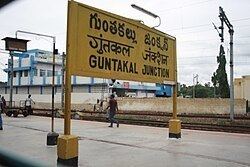Status Operational Line length 1,281 km (796 mi) Highest elevation 622 m | Opened 1871 Number of tracks 2/1 | |
 | ||
Track gauge 1,676 mm (5 ft 6 in) Broad gauge Electrification Partly electrified, rest being electrified Operators | ||
The Mumbai–Chennai line is a railway line connecting Chennai and Mumbai cutting across southern part of the Deccan Plateau. It covers a distance of 1,281 kilometres (796 mi) across Maharashtra, Karnataka, Telangana, Andhra Pradesh and Tamil Nadu.
Contents
Sections
The 1,281 km (796 mi) long trunk line, amongst the long and busy trunk lines connecting the metros, has been treated in more detail in smaller sections:
- Central Line (Mumbai Suburban Railway)
- Mumbai Dadar-Solapur section
- Solapur-Guntakal section
- Guntakal-Chennai Egmore section
History
The first train in India from Chhatrapati Shivaji Terminus in Mumbai to Thane ran on 16 April 1853 on a track laid by the Great Indian Peninsula Railway. The GIPR line was extended to Kalyan in 1854 and then on the south-east side to Khopoli via Palasdari railway station at the foot of the Western Ghats in 1856. While construction work was in progress across the Bhor Ghat, GIPR opened to public the Khandala-Pune track in 1858. The Bhor Ghat incline connecting Palasdari to Khandala was completed in 1862, thereby connecting Mumbai and Pune. GIPR extended its line to Raichur in 1871 and met the line of Madras Railway thereby establishing direct Mumbai-Chennai link.
The first train service in southern India and the third in India was operated by Madras Railway from Royapuram / Veyasarapady to Wallajah Road (Arcot) in 1856. Madras Railway extended its trunk route to Beypur / Kadalundi (near Calicut) and initiated work on a north-western branch out of Arakkonam in 1861. The branch line reached Renigunta in 1862. The branch line out of Arakkonam reached Raichur in 1871, where it connected to the Great Indian Peninsula Railway line from Mumbai.
Electrification
The Kalyan-Pune section was electrified with 1.5 kV DC overhead system in 1930 and was converted to AC overhead system in 2010.
The Pune-Solapur-Wadi line is being electrified with a loan of Rs. 1,500 crore from Asian Development Bank. Work was initiated in 2012.
Electrification work is in progress in the Pune-Wadi-Guntakal sector. As on 1 April 2012 the entire route of 641 km was shown as balance work.
Electrification of the 308 km long Renigunta-Guntakal section was announced in 2003 at a cost of Rs. 168 crore. The Renigunta-Nandalur sector electrification was completed in 2006. The Nandalur-Guntakal sector was electrified by Dec 2013.
The Chennai Beach-Tambaram sector was electrified with DC overhead line in 1931 and was converted to 25 kv AC in 1967. The Chennai Central-Tiruvallur sector, as well as the Basin Bridge-Chennai Beach sector were electrified in 1979-80. The Tiruvallu-Arakkonam sector was electrified in 1982-83, Arakkonam-Tiruttani sector in 1983-84 and the Tiruttani-Renigunta sector in 1984-85.
Speed limit
The Kalyan-Pune-Daund-Wadi-Secunderabad-Kazipet line and the Wadi-Raichur-Adoni-Arrakonam-Chennai Central line are classified as 'Group B' lines and can take speeds up to 130 km/h. However, the stretch between Mumbai CST and Kalyan is classified as 'Group A' lines, where trains can take speed up to 160 km/h.
Passenger movement
Pune, Solapur and Chennai Central, on this line, are amongst the top hundred booking stations of Indian Railway. Mumbai-Chennai line is a part of Diamond Quadrilateral.
